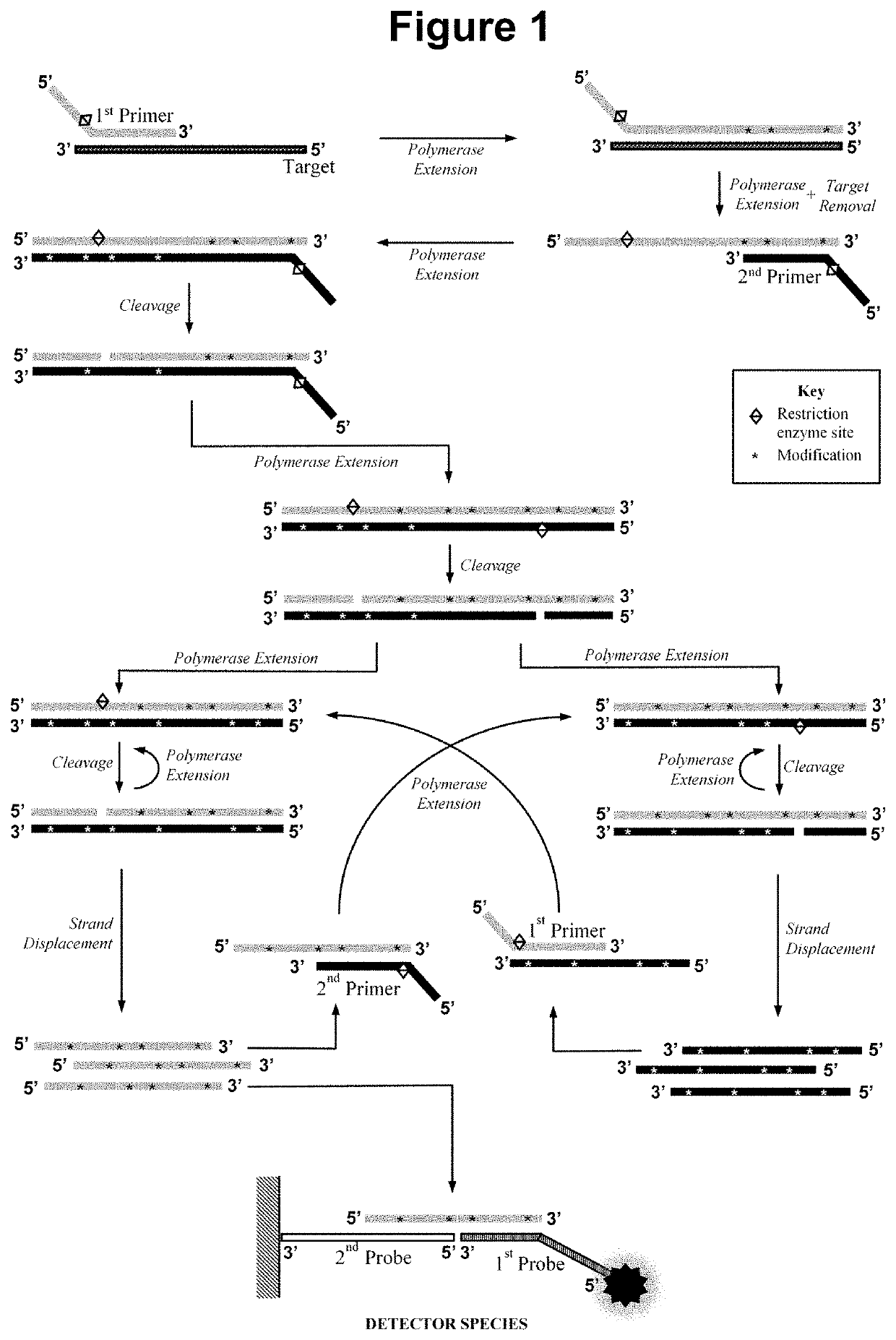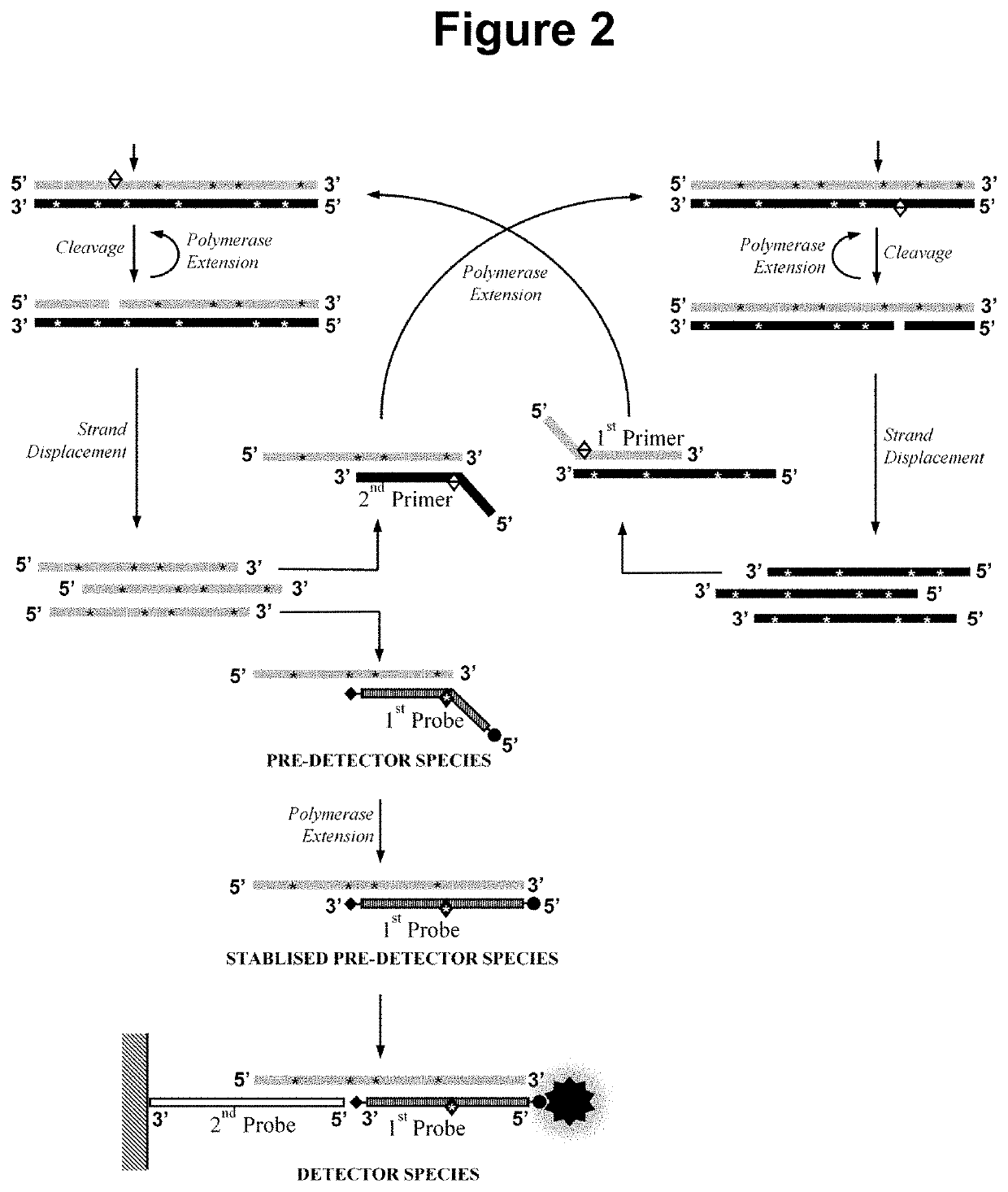Nucleic acid detection method
a detection method and nucleic acid technology, applied in the field of nucleic acid detection, can solve the problems of limiting the use of pcr-based methods in certain applications, limiting their potential for clinical diagnostics, and adding significant complexity to the method, so as to facilitate the detection of rapid and specific diseases, simple, rapid and low-cost
- Summary
- Abstract
- Description
- Claims
- Application Information
AI Technical Summary
Benefits of technology
Problems solved by technology
Method used
Image
Examples
example 1
Performance of the Method Wherein the Second Oligonucleotide Probe is Attached to a Solid Material, a Nitrocellulose Lateral Flow Strip
[0172]This example demonstrates the performance of the method wherein the second oligonucleotide probe is attached to a solid material, a nitrocellulose lateral flow strip, and the first oligonucleotide probe is not contacted with the sample simultaneously to the performance of the amplification step a).
[0173]The first oligonucleotide primer with a total length of 24 bases was designed comprising in the 5′ to 3′ direction: A stabilising region of 7 bases; the 5 bases of the recognition sequence for a restriction enzyme that is not a nicking enzyme; and a 12 base hybridising region comprising the reverse complementary sequence of the first hybridisation sequence in the target nucleic acid. The second oligonucleotide primer was designed to contain the same stabilising region and restriction enzyme recognition sequence, but with the 12 base hybridising ...
example 2
Performance of the Method Wherein the First Oligonucleotide Probe is Blocked at the 3′ End from Extension by the DNA Polymerase and is not Capable of being Cleaved by Either the First or Second Restriction Enzyme and is Contacted with the Sample in Step a)
[0178]This example demonstrates the performance of embodiments of the methods wherein the first oligonucleotide probe is blocked at the 3′ end from extension by the DNA polymerase and is not capable of being cleaved by either the first or second restriction enzyme and contacted with the sample simultaneously to the performance of step a). In such embodiments, we have not observed any significant inhibition of the rate of the amplification, indicating that the pre-detector species accumulates in real-time without disrupting the optimal cyclical amplification process. Not only have we not observed any inhibitory effects on the amplification process in said embodiments but we have observed a surprising enhancement of the signal produc...
example 3
Performance of the Method Wherein the Presence of Two or More Different Target Nucleic Acids of Defined Sequence are Detected in the Same Sample
[0186]This example demonstrates the potential of the method for the detection of two or more different target nucleic acids of defined sequence in a sample. The use of two oligonucleotide probes in addition to the primers in the method, provides an integral approach for detection of the amplification product in the method that is ideally suited to the detection of two or more different target nucleic acids in the same sample. In this example the ability to differentially detect alternative detector species based on the sequence specific hybridisation of the second oligonucleotide probe is demonstrated.
[0187]Firstly, in order to demonstrate the ability of the method to be employed for the detection of two or more different target nucleic acids we developed compatible sets of oligonucleotide primers and probes for detection of two distinct tar...
PUM
| Property | Measurement | Unit |
|---|---|---|
| temperature | aaaaa | aaaaa |
| temperature | aaaaa | aaaaa |
| temperature | aaaaa | aaaaa |
Abstract
Description
Claims
Application Information
 Login to View More
Login to View More - R&D
- Intellectual Property
- Life Sciences
- Materials
- Tech Scout
- Unparalleled Data Quality
- Higher Quality Content
- 60% Fewer Hallucinations
Browse by: Latest US Patents, China's latest patents, Technical Efficacy Thesaurus, Application Domain, Technology Topic, Popular Technical Reports.
© 2025 PatSnap. All rights reserved.Legal|Privacy policy|Modern Slavery Act Transparency Statement|Sitemap|About US| Contact US: help@patsnap.com



